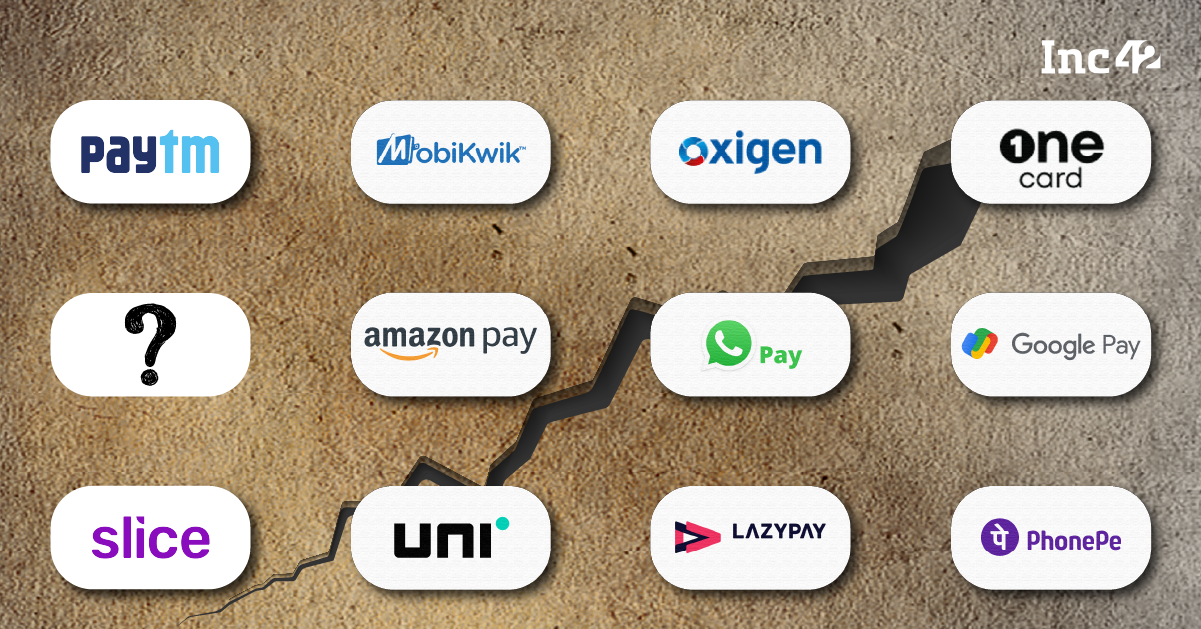In a notification addressed to non-bank PPIs, the RBI reportedly said that prepaid payment instruments cannot be loaded with credit lines
As per analysts, the RBI is essentially trying to remove any regulatory arbitrage that a wallet/ non-bank PPI may have versus a bank
While fintech players are awaiting clarification from the central bank, the notification raises questions on the business model of many of these players and threatens their existence
The June 20th RBI notification on PPI-MD (Prepaid Payment Instruments-Master Directions) not permitting loading of non-bank PPIs from credit lines has made the fintech ecosystem lose its sleep. At the same time, a Twitter debate is on within the consumers to understand the impact of the notification.
However, there is no official release available on the RBI website so far. Inc42 reached out to multiple players including Slice, LazyPay, MobiKwik, Capital Float, CashFree, KreditBee, Jupiter.Money to understand the impact of the notification. However, all these players refused to comment on the matter.
“There lies a lot of ambiguity here. We expect RBI to come up with a detailed explanation here,” one of the lendingtech NBFC’s CEO said on the condition of anonymity.
Nonbank vs Bank PPIs
An investor with investments in major BNPL companies in India explained that the notification is addressed to non-bank PPI issuers. These can be mobile wallets, a travel card issuer or someone who is using a non-bank issued PPIs for any other purpose.
In simple terms, pure play bank PPIs include players such as HDFC Flexipay, ICICI Paylater, HDFC Payzapp, SBI YONO, ICICI Pockets, among others. Among the non-bank PPIs are online wallets such as Paytm, PhonePe, GPay, WhatsApp Pay, MobiKwik, Oxigen, Amazon Pay, among others.
Others such as LazyPay, Ola Postpaid, Paytm Postpaid, Flipkart Pay Later, FreeCharge Pay Later, Jupiter Edge (by Jupiter.money), Slice, Uni, Fi, OneCard, among others , also fall under the non-bank PPI category.
“Ultimately, this means that a non-bank PPI player can partner with any NBFC or lending institution to offer a credit line unless it is routed through an RBI authorised bank and the partner bank can be monitored by RBI to keep a track of all lending transactions,” he added.
Which Non-Bank PPIs Will Be Impacted?
A simple example here would be Mobikwik. As per its website, to avail loan facility, one needs to just download the app, do the minimum wallet KYC to get instant approval for a loan, and then this credit will be routed to the user’s Mobikwik online wallet.
This means that the user is loading his Mobikwik wallet (non-bank PPI) through a credit line offered by Mobikwik in partnership with financial institutions, be it banks or NBFCs. Currently, Mobikwik has partnered with one bank, IDFC First Limited, and five NBFCs – Fullerton India Credit Company, Incred Financial Services, Western Capital Advisors, Home Credit India Finance, and Growth Source Financial Technologies. It is not clear whether the credit line is routed to the user’s wallet through the partnered bank or an NBFC with a bank partner.
Similar is the story with LazyPay. PayU Finance is one of the leading digital lenders and the NBFC unit of PayU, which owns Lazypay. At the same time, LazyPay has partnered with SMB Bank India and Visa to launch Lazy Card, which offers a credit limit of up to Rs 5 Lakh to the user.
The notification raises questions on such companies’ existing business model as they miss clarity on where the credit line is effectively sourced from and if that falls under RBI’s new guidelines.
Analysts are further of the view that BNPL offerings such as Slice, OneCard, and Uni among others, primarily known as Challenger Credit Cards, as well as post-paid services, such as Paytm Postpaid, will be impacted by the notification. Many of these BNPL players source their credit from NBFCs which do not have a direct affiliation with banks to source their funds.
For instance, Jupiter.money, a neobanking platform, has launched Jupiter Edge, which allows a credit of up to INR 20K. Here the transactions are made through its parent company LivQuik’s escrow account in IDFC First Bank, which is regulated by the RBI.
On the contrary, players like Slice have partnered with NBFCs such as Quadrillion Finance Private Limited, DMI Finance Private Limited, Northern Arc Capital Limited, and Vivriti Capital Private Limited. Then, there is Paytm Postpaid, where the credit is facilitated by Clix capital, an NBFC which came into function post acquiring GE Capital’s commercial lending and leasing business in 2016.
The RBI sees these transactions as “deposits” at NBFCs’ end. There is no clarity on the end consumer who is availing the loan, as KYC is done for challenger credit cards and wallet companies.
As founder of portfolio management service (PMS) Capital Mind, Deepak Shenoy, tweeted, “NBFCs can’t have accounts that allow you to pay using them and issue cards. You can take the money into your bank account and pay from the bank. NBFCs aren’t allowed to issue cards.”
This again puts a question mark on whether these challenger credit card companies will be able to justify that their business model is in accordance with the RBI guidelines, or will have to immediately suspend their operations.
Possible Reasoning For RBI’s Decision
The step has been taken as the KYC guidelines for a wallet are less strict as compared to that of a credit card. The RBI is essentially trying to remove any regulatory arbitrage that a wallet/ non-bank PPI may have versus a bank where the drop-off rate is very high, whether it’s a personal loan, credit card, debit card, or any kind of credit.
Also, BNPL is growing at a really fast pace in India. In addition to pure-play BNPL startups, such as Simpl, Lazypay, Zestmoney, ePayLater, ecommerce marketplaces Flipkart and Amazon India also offer their own BNPL products, while even fintech and payments startups such as PhonePe (via Flipkart) and Paytm have ventured into this territory.
Simpl, for example, is working with over 2,500 merchants and has over 7 Mn active users. Posting a compound annual growth rate (CAGR) of 36%, India’s BNPL sector is expected to reach $100 Bn by the end of 2023, which indicates just how popular these lending platforms are even in their infancy.
As of now, the RBI is having a hard time tracking the PPI transactions routed through wallets or NBFCs. These NBFCs, or even the partnered banks, are currently disseminating loans on the basis of paying capacity of the PPI platforms. With this notification, the central bank is aiming to bring the end user directly under the lens of partnered banks to avail the desired loans.
One can also see this decision of the RBI as a favour to banks or card companies such as Mastercard and Visa. Fintechs might ask if the RBI is against innovation that these tech companies are aiming to bring into the ecosystem.
Last week, RBI Governor Shaktikanta Das said that the central bank is monitoring new fintech products like BNPL, and is not looking to regulate them currently.
“BNPL, which is now offered by several ecommerce companies, also comes under lending activity. We have to be careful and calibrated in our approach and not start interfering everywhere…Let them carry on with their business,” the governor said.
Inc42 Take
The notification will force several non-bank PPIs, including even unicorns and soonicorns, to change their business models. They might have to partner with credit card players for co-branded card issuance or acquire an NBFC as well as credit card licence themselves.
For some,, this might be an end to credit as a revenue model and they will become just prepaid cards or classic BNPL models. Not only this will be a blow to the partner NBFC ecosystem thriving on the digital lending boom with these new-age fintechs, it will also be a blow to the investors who have made investments in these companies at multiple valuations (even overvalued) based on their future growth potential in the India market.
Nevertheless, the industry is seeking more clarity from the RBI on this and is hoping for the best.









![Read more about the article [Funding alert] CpaaS company CometChat raises $10M in Series A round](https://blog.digitalsevaa.com/wp-content/uploads/2021/12/cometchat-1638863383406-300x150.png)
